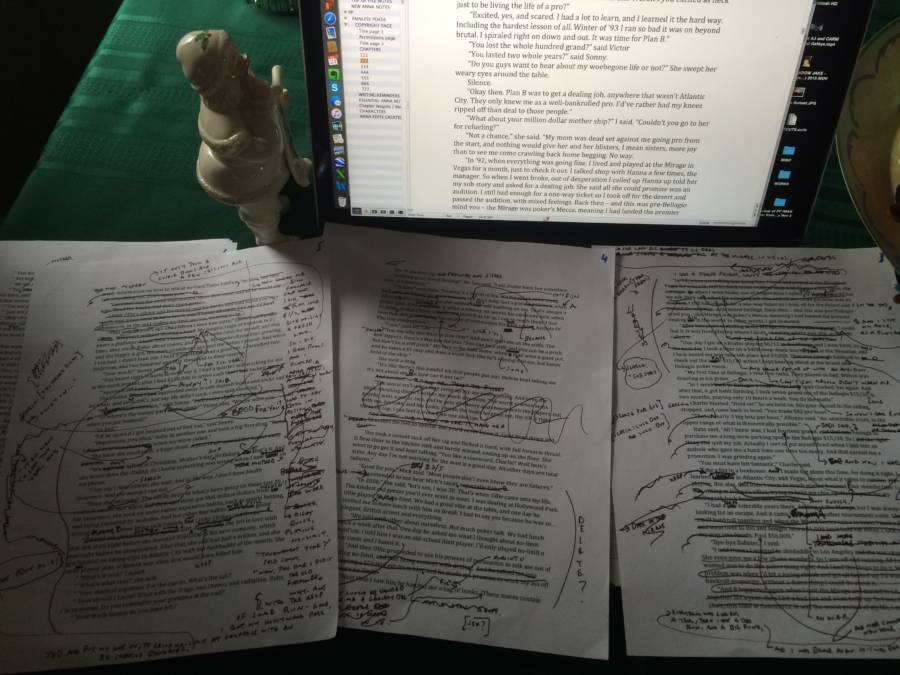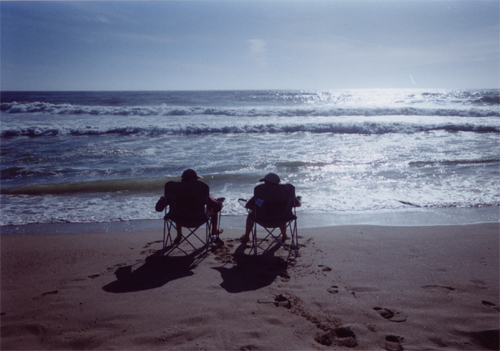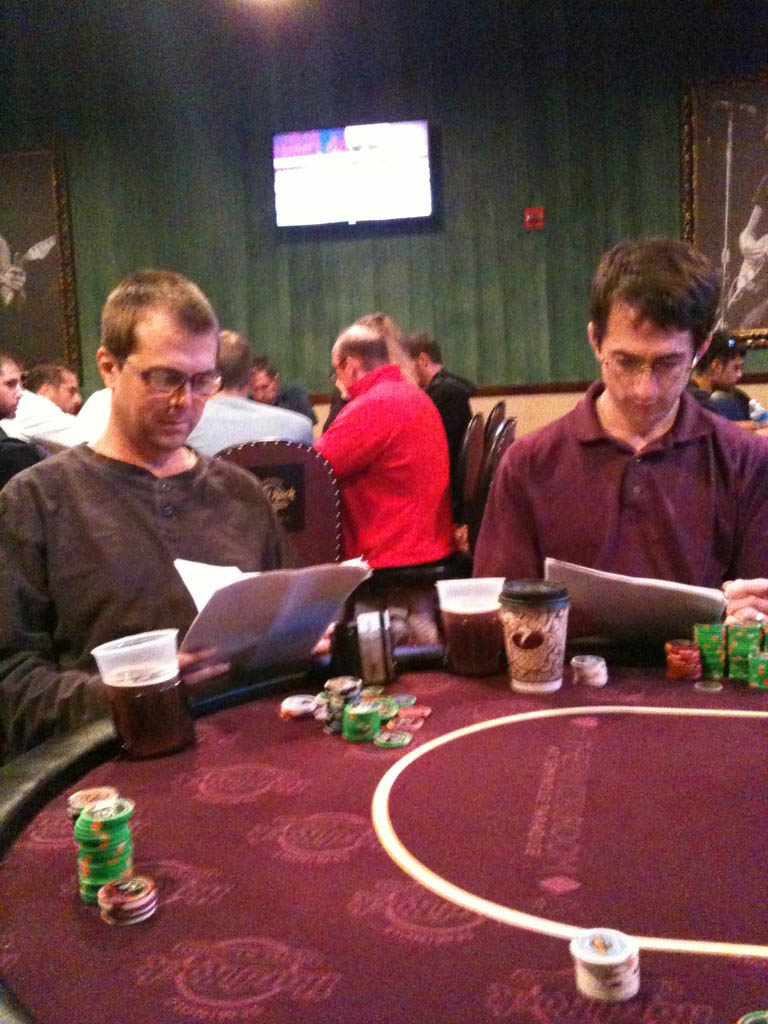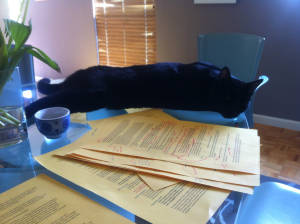The Making of Painless Poker
(This version is longer than the one in the book. And it has pictures.)
It was like a viral infection that grew undetected until it was too late. First exposure was in 2008 when I became a collector of questions, objections, and obstacles. Questions about how to fix tilt. Objections to my answers. Obstacles we all face. I gathered words. Words from clients, and from posts at DeucesCracked, where each episode of EPTPE generated long threads of questions and comments.
And pains. I became a pain collector. How’s that for a hobby? Clients were opening up to me about what was hurting them in ways that friends and family never had. And I took notes. When they told me their troubles, my book got longer. And I didn’t even know I was writing one.
Writers are often depicted as having stacks of stuff everywhere, and insisting that they know where everything is. I have a place like that. I call it “my computer.” In the summer of ’09, I had amassed two years’ worth of disparate works, scattered around in various files and folders and subfolders. Writing projects, coaching materials, saved links, emails, quotes and notes and anecdotes and god what a mess. It was time to clean house.
In the process of grouping like with like, I copied everything into one impeccably outlined Word document and called it THE FILE. The plan was to sort through THE FILE and see what was salvageable, and then divide it up into well-named files, motivated all the while by the writer’s drive to know where shit is.
But I never split it up. I never had a chance. I was too busy adding on. Wherever I was, I kept jotting things down to put in THE FILE when I got home. That went on for six months. I was in there every day, for an hour or two, dinking around, fleshing things out, revising, rearranging, adding on.
Is this a book you’re working on?
I suppose it could be.
What would you call it?
I do not possess the technology to write notes in the shower. But I do keep my phone by the sink so that if I think of something I don’t want to forget, I can step out of the shower and poke my phone and record it.
On February 6, 2010, when I thought of Painless Poker in the shower, I did not need to drip across the floor. This was unforgettable.
I made calls and wrote letters to friends who knew I’d been searching for a title because they’d heard me try to sell them, and myself, on the previous attempts:
Poker and Peace
Mum Poker
Mindful Poker
I knew that none of those titles was the final answer because I saw no sparks when I said them, and because my explanations flailed.
This time was different. I told a neighbor about the title. He plays in a small-stakes home game once per week. When he heard the words painless poker, he said, “Not in a million years.” I told my friend Dave the title and he said, “You’re writing a comedy?” My friend Doug replied by email with: “It’s funny how this title could have hidden in plain sight for so long.”
But it wasn’t the stand-alone awesomeness of the title that changed everything. The words Painless Poker would be my outline, and my filter, and my perspective. Once placed under those two words, my 400-page file of collected crap became a book in progress.
Kay and I had another one of our sit-downs. We decided that I would stop taking on new clients, and that I would be chained to my desk until I finished a book called Painless Poker.
As embryos, EOP and PP were indistinguishable. Both began as a clothesline that I hung stuff on. Elements maintained the clothesline structure to completion. For Painless, I wanted a different model. I wanted it to flow from the front to the back, like a reading book, rather than a teaching book. I had the idea – more like a fantasy – of writing a first draft from beginning to end, plowing into nowhere the whole time.
Me and Alex
On July 10, 2010, I wrote in my journal:
Alex and I had a big talk about Painless Poker. He insisted that it be story. I decided to start the book totally over, and lead off with going busto in St. Louis.
And that’s when the project took off, when I had a story to tell. I sent the file to Anna. She sent it back with a hundred stimulating comments that propelled me forward. I started logging my writing time. I started reading about writing again. Shit was happening.
While working on the St. Louis story – which, by the way, is 100% true except for the made-up parts – the sentence, “Don’t even talk to me about how bad it hurts,” showed up, and I knew I had a possible keeper for the opening line of the book. Big buzz. And then, when I got to the end of the story and wrote, “Okay, now you can talk to me,” I was like, good, this is good, these are bookend sentences. Sleek, sturdy bookends. I had given birth to my first-ever bouncing baby chapter.
I sent it to Alex. That was November 2010. He printed it out and took it with him on a trip to Florida where he would be playing poker with our mutual friend, Matt Flynn.
It was a happy spike in my writing career, and also horrific, when Matt texted me this picture:
That’s Alex and Matt, editing my child, while playing in a $10/25 no-limit game. Yes, they are editing at the table. A table with north of $100,000 on it. And my best buddies are passing 20 sheets of my pain back and forth, calmly making notes on the pages to tell me what needs fixed, while drinking their black coffees and Sam Adams Oktoberfest beers.
I worked their suggestions into the text. Alex read it again and signed off on the St. Louis story as, “Good enough for now.”
Then I was alone with the question:
What happens next?
Steven King says to ask that question over and over when you’re writing.
What happens next?
It never came up during the making of EOP, partly because EOP was not a storybook, but mainly because I hadn’t learned to ask that question yet. And I sure needed an answer to it now.
“Okay, now you can talk to me.”
If those were going to the last words of Chapter 1, then it seemed like “What happens next” should be someone talking to me.
Oh! I know! I’ll hit the reader with one of the main questions from my collection, the one that the title invites:
Is painless poker possible?
Okay. That’ll work, as a start for chapter two.
But who is asking the question?
And that’s when the biosynthesis began, right there inside THE FILE. Life was finding a way. I had questions that only an internet player would ask, questions that only a bad quitter would ask, questions that only a family man would ask, and so forth. While grouping the questions, I found myself formulating the askers…
I’ll need an internet grinder. I could call him Charlie. Charlie is a friendly name. Charlie Grinder. Okay, maybe not. And I’ll need a hyper-logical guy. And a hothead player, to representing the easily agitated, and I’ll go ahead and have that same guy have problems at home regarding poker, and should I have a crazy Asian? And maybe a stoner? And maybe a girl? I’ve got it! I’ll use my pain collection! I will assign pains to my characters that fit their lifestyles. Oh these poor monsters. This is splendid.
Maybe group therapy would be a good setting, and funny. It could be how I envisioned doing workshops, with me and half a dozen poker players sitting around a poker table. I told Alex about this idea and he said to call the group Pain Anonymous. I like the idea of naming the group, but not with “anonymous.” Too much pre-meaning and stigma. Today I thought of THE PAINLESS POKER CLINIC. That’s a likely keeper.
Why are these composite characters at the clinic? Did they pay for coaching?
No. Let’s make them unwilling participants. They were brought in, no, beamed in, yeah, that’s it. They were beamed in, at their moment of greatest pain.
Oh my. This is rich.
Suddenly I had much to do. I had people to invent. I had stories to make up. Exhilaration turned to terror when I realized I’d be writing reams of dialogue for the first time ever, spoken by actual fabricated people. And these people would have backstories, and arcs, and there’d be plots, and settings, and…
I need to talk to Jay.
Jay said people get sucked into writing fiction because they are naïve. “Like the guy who thinks he can walk across the quicksand.”
“So what do I do now?”
“Don’t fight it,” he said. “Dive on in and drown with the rest of us.”
And I thought, What an interesting character Jay is. Perhaps I could transmute some of his qualities into one of the characters at the clinic.
And then I thought, He’s right, I’m toast. And I bought a batch of books on how to write fiction.
I wrestled hard with this question: If Painless Poker is fiction, then what becomes of the St. Louis story? It sort of fits, in that it’s basically my beam-in story. Plus Alex and Wayne have encouraged me for years to tell more stories about myself. Maybe I should include other true stories too, about my poker path, and my meditation path. But how can first-person narrative from my real life fit into a book about a fantasy poker workshop? How bumpy would the reader’s ride be if I laid memoir alongside fiction under one title?
I figured you could handle some jostling, and I decided to write two stories, one about my actual life, and the other about whatever transpired at the clinic. I would produce “shitty first drafts,” as Anne Lamott calls them, using my curated content as a roadbed, and then revise for years while enjoying an urban monastic lifestyle.
And that’s what happened next. Thank you, Kay!
ADD Painless Poker TO CART
ADD Painless Poker TO CART
2018 Coaching Update: I’m doing video coaching now on whatever ails you — from betting problems and tilt issues to bad quitting and no patience. For more details and to schedule a call, click here.





Add Comment